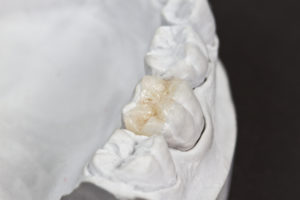 When teeth need large cavities to be filled (or we need to replace an old large filling with another one) then porcelain onlays are an excellent replacement. Porcelain fillings come from the ceramic family and are combined with quartz glass silica to give them a translucent, tooth-like appearance.
When teeth need large cavities to be filled (or we need to replace an old large filling with another one) then porcelain onlays are an excellent replacement. Porcelain fillings come from the ceramic family and are combined with quartz glass silica to give them a translucent, tooth-like appearance.
Dental porcelains have come a long way compared to 20 years ago. Two decades ago dentists limited their use to only small dental fillings and front teeth veneers. In the past colour matching was a problem, they were prone to fracturing and keeping them stuck onto the teeth was an issue.
Today, we can offer you an almost infinite array of metal-free porcelain inlays for any part of the mouth with a similar lifespan to metal fillings.
The clear advantages of porcelain fillings over metal are their strength when bonded to the tooth, they match the tooth colour, and do not stain easily. Very little dental plaque is attracted to its surface which means your gums stay healthy. Furthermore, they do not conduct temperature or electrical current like metallic fillings and are more biocompatible. Whilst allergic reactions to metallic fillings are known and documented, a true ceramic allergy in the mouth is very rare.
Unlike composite resin fillings, porcelain fillings do not contain Bis-GMA or other free monomers which can leach out into the mouth and compromise their own strength. They do not absorb water easily and less likely to fail from the constant temperature changes in the mouth.
Whilst porcelain fillings are initially cost more to have made than a regular white resin or metallic fillings, their long lifespan, strength and appearance often make them the best choice for your mouth.
